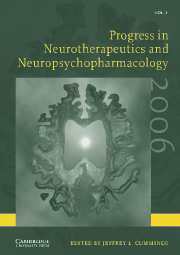Book contents
- Frontmatter
- Contents
- Preface
- Contributors
- Introduction to neurotherapeutics and neuropsychopharmacology
- Rivastigmine in the treatment of dementia associated with Parkinson's disease: a randomized, double-blind, placebo-controlled study
- Modafinil for the treatment of fatigue in multiple sclerosis
- Radiotherapy with concurrent and adjuvant temozolomide: a new standard of care for glioblastoma multiforme
- Treating migraine attacks ASAP: concept and methodological issues
- Early phase trials of minocycline in amyotrophic lateral sclerosis
- Creatine as a potential treatment for amyotrophic lateral sclerosis
- AVP-923 as a novel treatment for pseudobulbar affect in ALS
- Liquid fluoxetine versus placebo for repetitive behaviors in childhood autism
- Testing multiple novel mechanisms for treating schizophrenia in a single trial
- Selegiline in the treatment of negative symptoms of schizophrenia
- Analysis of the cognitive enhancing effects of modafinil in schizophrenia
- Efficacy and tolerability of ziprasidone and olanzapine in acutely ill inpatients with schizophrenia or schizoaffective disorder: results of a double-blind, six-week study, with a six-month, double-blind, continuation phase
- Subject index
- Author index
Treating migraine attacks ASAP: concept and methodological issues
Published online by Cambridge University Press: 22 March 2010
- Frontmatter
- Contents
- Preface
- Contributors
- Introduction to neurotherapeutics and neuropsychopharmacology
- Rivastigmine in the treatment of dementia associated with Parkinson's disease: a randomized, double-blind, placebo-controlled study
- Modafinil for the treatment of fatigue in multiple sclerosis
- Radiotherapy with concurrent and adjuvant temozolomide: a new standard of care for glioblastoma multiforme
- Treating migraine attacks ASAP: concept and methodological issues
- Early phase trials of minocycline in amyotrophic lateral sclerosis
- Creatine as a potential treatment for amyotrophic lateral sclerosis
- AVP-923 as a novel treatment for pseudobulbar affect in ALS
- Liquid fluoxetine versus placebo for repetitive behaviors in childhood autism
- Testing multiple novel mechanisms for treating schizophrenia in a single trial
- Selegiline in the treatment of negative symptoms of schizophrenia
- Analysis of the cognitive enhancing effects of modafinil in schizophrenia
- Efficacy and tolerability of ziprasidone and olanzapine in acutely ill inpatients with schizophrenia or schizoaffective disorder: results of a double-blind, six-week study, with a six-month, double-blind, continuation phase
- Subject index
- Author index
Summary
Key words: Migraine; clinical trials; neurotherapeutics; triptans; allodynia; placebo effects; responder rates.
Introduction
Migraine is a common neurovascular disorder characterised by recurrent attacks of moderate to severe headache with nausea and/or photo- and phonophobia. Triptans, selective serotonin 5-HT1B/1D agonists, are specific acute migraine drugs of which efficacy and safety are well established in numerous clinical trials (Goadsby et al., 2002; Ferrari et al., 2001). Efficacy is usually presented as the response rate, the proportion of patients whose headache improved from severe or moderate pain at baseline to mild or no pain at 2-h post-dose (Figure 1) (Tfelt-Hansen et al., 2000). Consequently, in clinical trials of triptans in acute migraine, patients have traditionally been required to take their medication only when their pain had reached a moderate or severe intensity. There are good methodological reasons for this somewhat artificial design. If patients wait until a moderate or severe pain level has been reached, it is more likely that true migraine headaches are being treated rather than a non-migraine (e.g. tension-type) headache (Tfelt-Hansen et al., 2000). Delayed treatment should also minimise the placebo response, allowing for spontaneous resolution of possible short, non-migraine headaches. It also simplifies the assessment of the improvement as all patients start from a similar level of baseline pain rather than from different levels: a shift from severe to moderate pain is not the same as improvement from mild to no pain.
- Type
- Chapter
- Information
- Publisher: Cambridge University PressPrint publication year: 2006



